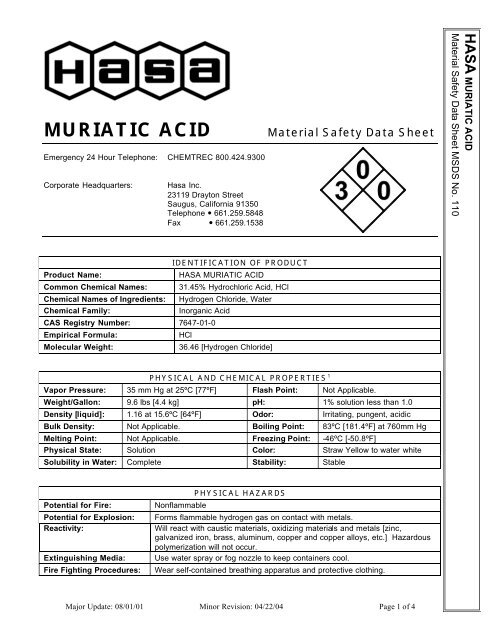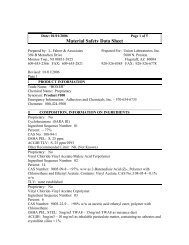Muratic Acid
Muratic Acid
Muratic Acid
Create successful ePaper yourself
Turn your PDF publications into a flip-book with our unique Google optimized e-Paper software.
MURIATIC ACID<br />
Emergency 24 Hour Telephone: CHEMTREC 800.424.9300<br />
Corporate Headquarters:<br />
Hasa Inc.<br />
23119 Drayton Street<br />
Saugus, California 91350<br />
Telephone — 661.259.5848<br />
Fax — 661.259.1538<br />
Material Safety Data Sheet<br />
HASA MURIATIC ACID<br />
Material Safety Data Sheet MSDS No. 110<br />
IDENTIFICATION OF PRODUCT<br />
Product Name:<br />
HASA MURIATIC ACID<br />
Common Chemical Names: 31.45% Hydrochloric <strong>Acid</strong>, HCl<br />
Chemical Names of Ingredients: Hydrogen Chloride, Water<br />
Chemical Family:<br />
Inorganic <strong>Acid</strong><br />
CAS Registry Number: 7647-01-0<br />
Empirical Formula:<br />
HCl<br />
Molecular Weight:<br />
36.46 [Hydrogen Chloride]<br />
PHYSICAL AND CHEMICAL PROPERTIES 1<br />
Vapor Pressure: 35 mm Hg at 25ºC [77ºF] Flash Point: Not Applicable.<br />
Weight/Gallon: 9.6 lbs [4.4 kg] pH: 1% solution less than 1.0<br />
Density [liquid]: 1.16 at 15.6ºC [64ºF] Odor: Irritating, pungent, acidic<br />
Bulk Density: Not Applicable. Boiling Point: 83ºC [181.4ºF] at 760mm Hg<br />
Melting Point: Not Applicable. Freezing Point: -46ºC [-50.8ºF]<br />
Physical State: Solution Color: Straw Yellow to water white<br />
Solubility in Water: Complete Stability: Stable<br />
Potential for Fire:<br />
Potential for Explosion:<br />
Reactivity:<br />
Extinguishing Media:<br />
Fire Fighting Procedures:<br />
Nonflammable<br />
PHYSICAL HAZARDS<br />
Forms flammable hydrogen gas on contact with metals.<br />
Will react with caustic materials, oxidizing materials and metals [zinc,<br />
galvanized iron, brass, aluminum, copper and copper alloys, etc.] Hazardous<br />
polymerization will not occur.<br />
Use water spray or fog nozzle to keep containers cool.<br />
Wear self-contained breathing apparatus and protective clothing.<br />
Major Update: 08/01/01 Minor Revision: 04/22/04 Page 1 of 4
HEALTH HAZARDS<br />
Signs and Symptoms of Exposure:<br />
Eyes and skin burns. Not a skin sensitizer.<br />
Medical Conditions Aggravated by Exposure: No data available.<br />
Oral [ingestion] LD 50 :<br />
900 mg/kg 2 [rat]<br />
Dermal [skin absorption] LD 50 :<br />
No data available.<br />
Inhalation [breathing] LC 50 : 3124 ppm [1 hour, rat] 3<br />
Eye Irritation: Corrosive. Will burn eyes on contact. 4<br />
Skin Irritation: Corrosive. Not considered to be a skin sensitizer. 5<br />
OSHA PEL: 5 ppm [ceiling] 6<br />
ACGIH TLV/TWA: 5 ppm [as HCl] 7<br />
POTENTIAL ROUTE [S] OF ENTRY<br />
Inhalation [Breathing]: Inhalation of fumes.<br />
Dermal [Skin]:<br />
Liquid contact.<br />
Eyes:<br />
Fumes and/or liquid contact.<br />
Ingestion:<br />
Swallowing of liquid.<br />
HASA MURIATIC ACID<br />
Material Safety Data Sheet MSDS No. 110<br />
AQUATIC AND ENVIRONMENTAL TOXICITY<br />
96-hour LC 50 [Mosquito Fish]: 282 mg/l 8<br />
96-hour LC 50 [Blue Gill]: 100% pH lowered to 3.6 9<br />
CARCINOGENIC [CANCER POTENTIAL] INFORMATION<br />
No evidence of bone, lung, or nasal tumors found in rats chronically exposed to HCl vapors. 10<br />
National Toxicological Program [NTP] Sixth Annual Report on Carcinogens:<br />
International Agency for Research on Cancer [IARC] Monographs, V. 1-53, Supps. 1-8:<br />
Listed by Federal OSHA as Carcinogens:<br />
Safe Drinking Water and Toxic Enforcement Act of 1986 [Proposition 65, California only]:<br />
Not listed.<br />
Not listed.<br />
Not listed.<br />
Not listed.<br />
GENERAL PRECAUTIONS FOR SAFE USE AND HANDLING<br />
Store in a cool, dry place. Do not mix with alkaline materials or metals. Keep container closed and protected<br />
against physical damage. Separate from incompatible materials in storage areas. Store separated from<br />
oxidizers. Keep containers closed when not in use. Keep out of the reach of children.<br />
PERSONAL PROTECTION AND HYGIENE<br />
Wear rubber gloves and eye protection when handling. Goggles should be vapor proof. Wash hands after<br />
handling. Provide ventilation for storage and use areas. Wear impervious clothing when handling and using<br />
this product. Do not breathe vapor. Avoid contact with skin and clothing.<br />
CLEAN-UP OF SPILLS<br />
Neutralize liquid with soda ash, sodium sesquicarbonate, slaked lime, or sodium bicarbonate and flush to a<br />
sanitary sewer.<br />
Major Update: 08/01/01 Minor Revision: 04/22/04 Page 2 of 4
Eye Contact:<br />
Skin Contact:<br />
Ingestion<br />
[swallowing]:<br />
Inhalation:<br />
FIRST AID<br />
Flush with water. Remove contact lenses [if applicable]. Hold eyelids open. Continue<br />
flushing with water for 15 minutes. Get prompt medical attention.<br />
Wash affected area with water for 15 minutes. Get medical attention.<br />
Drink large quantities of water. DO NOT induce vomiting. Call a physician or poison control<br />
center immediately.<br />
Move to a safe area. If not breathing, give artificial respiration. Call a physician immediately.<br />
FEDERAL/STATE LISTS/REGISTRATION/S/REPORTING REQUIREMENTS<br />
CERCLA Hazardous Substance<br />
RQ 5,000 lbs<br />
[Section 1010 [4], P.L. 96-510]:<br />
[1644 gallons based on HCl in solution]<br />
Extremely Hazardous Substance [40 CFR 355, Appendix A]: Not listed.<br />
Pesticide Product 7 U.S.C. 136 et seq.:<br />
Toxic Substance under TSCA:<br />
Pesticide Product [various State Laws]:<br />
Department of Agriculture:<br />
Not registered.<br />
Yes<br />
Not used for pesticidal purposes.<br />
GRAS when used in accordance with<br />
good manufacturing practices.<br />
HASA MURIATIC ACID<br />
Material Safety Data Sheet MSDS No. 110<br />
MATERIAL CLASSIFICATION<br />
OSHA Hazard Communication Standard, Department of Labor, Corrosive Liquid<br />
Occupational Safety and Health Division, 29 CFR 1910.1200:<br />
Department of Transportation CFR 49 Shipping Description: Hydrochloric <strong>Acid</strong>, 8, UN 1789, P.G. II<br />
[4-1 gallon returnable bottles in plastic<br />
crate add “DOT-E-6614” after “P.G. II.”]<br />
National Fire Protection Association NFPA 704 [1990]: 3-0-0<br />
BOCA National Fire Prevention Code/National Building Code [1999editions]: Corrosive Liquid<br />
Standard Fire Prevention Code/Standard Building Code [1997 editions]: Corrosive Liquid<br />
Uniform Fire Code/Uniform Building Code [1997 editions]:<br />
Corrosive Liquid<br />
Uniform Fire Code Standards 79-3, Uniform Fire Code, V. II [1997 edition]: 3-0-0<br />
Major Update: 08/01/01 Minor Revision: 04/22/04 Page 3 of 4
FOOTNOTES [REFERENCES]<br />
1 E.I. Dupont de Nemours Company, Memo [January 31, 1990]<br />
2 Biochemische Zeitschrift [Berlin, Germany] 134, 437, 23<br />
3 MacEwan, J.D. and E.H. Vernot, NTIS Pub. No. Ad-AO31860 [1976] [CA 86:13442x][J-2798]: Vernot E. H. et al.,<br />
Toxicology and Applied Pharmacology, 422 [2]:97-100 [1975]; Wohlsliagel, J. et al., Aerospace Medical Research<br />
Laboratories, AMRL-TR-125, pp. 275-285 [1975]; Wohlsliagel, J. et al., Journal Combustion Toxicology, 3[2]:61-70,<br />
[1976].<br />
4 Griffith, J.F. et al, Toxicology and Applied Pharmacology, 55[3]: 501-513 [1081].<br />
5 Gad, S.C. et al., Toxicology and Applied Pharmacology, 84[1]: 93-114.<br />
6 29 CFR 1910.1000<br />
7 ACGIH Bulletin.<br />
8 Wallen, I.E. et al., Sewage Industrial Wastes, 29:695 [1957] cited in McKee, J.E. et al., Water Quality Criteria. 2 nd<br />
Edition, 1963.<br />
9 Calms, J. Jr., et al., Proceedings 13 th Ind. Wastes Conf., Purdue University Engineering Bulletin, 43:243-252 [1959].<br />
10 Albert, R.E., et al., Journal National Cancer Institute, 68[4]:597-603 [1982]; Ballou, J.E. et al., Pac. Northwest Lab<br />
Annu. Re. DOE Asst. Sec. Environ. Report No. PNL-2500-Pt. 1, 6.1-6.2 [1978]: Sellakumar, A.R. et al., Proceedings<br />
American Association of Cancer Research, 24:94 [1083].<br />
HASA MURIATIC ACID<br />
Material Safety Data Sheet MSDS No. 110<br />
Please Note: The information contained herein, while not guaranteed, was prepared by competent technical<br />
personnel and is true and accurate to the best of our knowledge and belief. NO WARRANTY OR<br />
GUARANTEE, expressed or implied, is made regarding the product performance, product stability, or as to<br />
any other condition of use, handling, transportation, and storage. Customer use, handling, transportation, and<br />
storage may involve additional safety and/or performance considerations. Our technical personnel will be<br />
happy to respond to questions regarding safe handling, storage, transportation and use procedures. The safe<br />
handling, storage, transportation and use procedures remain the sole responsibility of the customer. No<br />
suggestions for handling, storage, transportation or use are intended as or to be construed as<br />
recommendations which may infringe on any existing patents or violate any Federal, State, and/or local law<br />
and/or regulation, ordinance, standard, etc.. This Material Safety Data Sheet has been prepared by HASA,<br />
Inc. staff from test reports and other information available in the public domain.<br />
Major Update: 08/01/01 Minor Revision: 04/22/04 Page 4 of 4
















